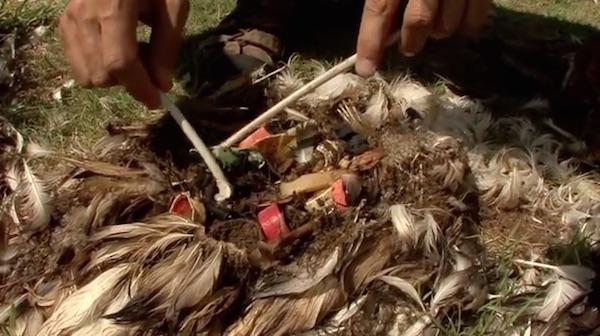Seabirds Gorging on Plastic, Mistaking It for Food: Study

The stomachs of a whopping 90 percent of the world's seabirds contain plastic that they have eaten, and by 2050 the number could be at 99 or 100 percent, according to recent findings. And it could kill them.
The plastic in question includes bags, bottle caps, and plastic clothing fibers, the researchers said in a media release from the Commonwealth Scientific and Industrial Research Organisation (CSIRO). The items wash out into the ocean from urban rivers, sewers and waste deposits, they said. Birds then ingest them, mistaking them for food, causing “gut impaction, weight loss and sometimes even death,” the media release said.
“For the first time, we have a global prediction of how wide-reaching plastic impacts may be on marine species—and the results are striking,” said CSIRO Oceans and Atmosphere senior research scientist Chris Wilcox, who led the study along with co-authors Denise Hardesty and Erik van Sebille. “We predict, using historical observations, that 90 percent of individual seabirds have eaten plastic. This is a huge amount and really points to the ubiquity of plastic pollution.”
“Since this material is not able to pass through the animal, these birds are likely to die as a result,” PBS’s Nova reported in September.
A good 8.8 million tons of plastic waste make their way into the world’s oceans annually, which as BBC News put it earlier this year, “is like covering an area 34 times the size of New York's Manhattan Island to ankle depth.”
The Australian and UK researchers reported their findings in the journal PNAS in September.
“We performed a spatial risk analysis using predicted debris distributions and ranges for 186 seabird species to model debris exposure,” the researchers wrote in their abstract. “We adjusted the model using published data on plastic ingestion by seabirds. Eighty of 135 (59 percent) species with studies reported in the literature between 1962 and 2012 had ingested plastic, and, within those studies, on average 29 percent of individuals had plastic in their gut.”
The study was not without encouraging news. The trend is reversible, the researchers said, if humans improve their waste stream management.
“We predict that plastics ingestion is increasing in seabirds, that it will reach 99 percent of all species by 2050, and that effective waste management can reduce this threat,” they wrote.
A graphic demonstration of just what this means was given by documentary filmmaker Chris Jordan on a 2010 research trip to Midway Island, where he pulled apart the carcass of a decaying albatross to reveal a stomach full of everything from bottle caps to a fishing float to a pen cap. A summary of his findings are in the video below.
Read more at http://indiancountrytodaymedianetwork.com/2015/10/27/seabirds-gorging-plastic-mistaking-it-food-study-162225